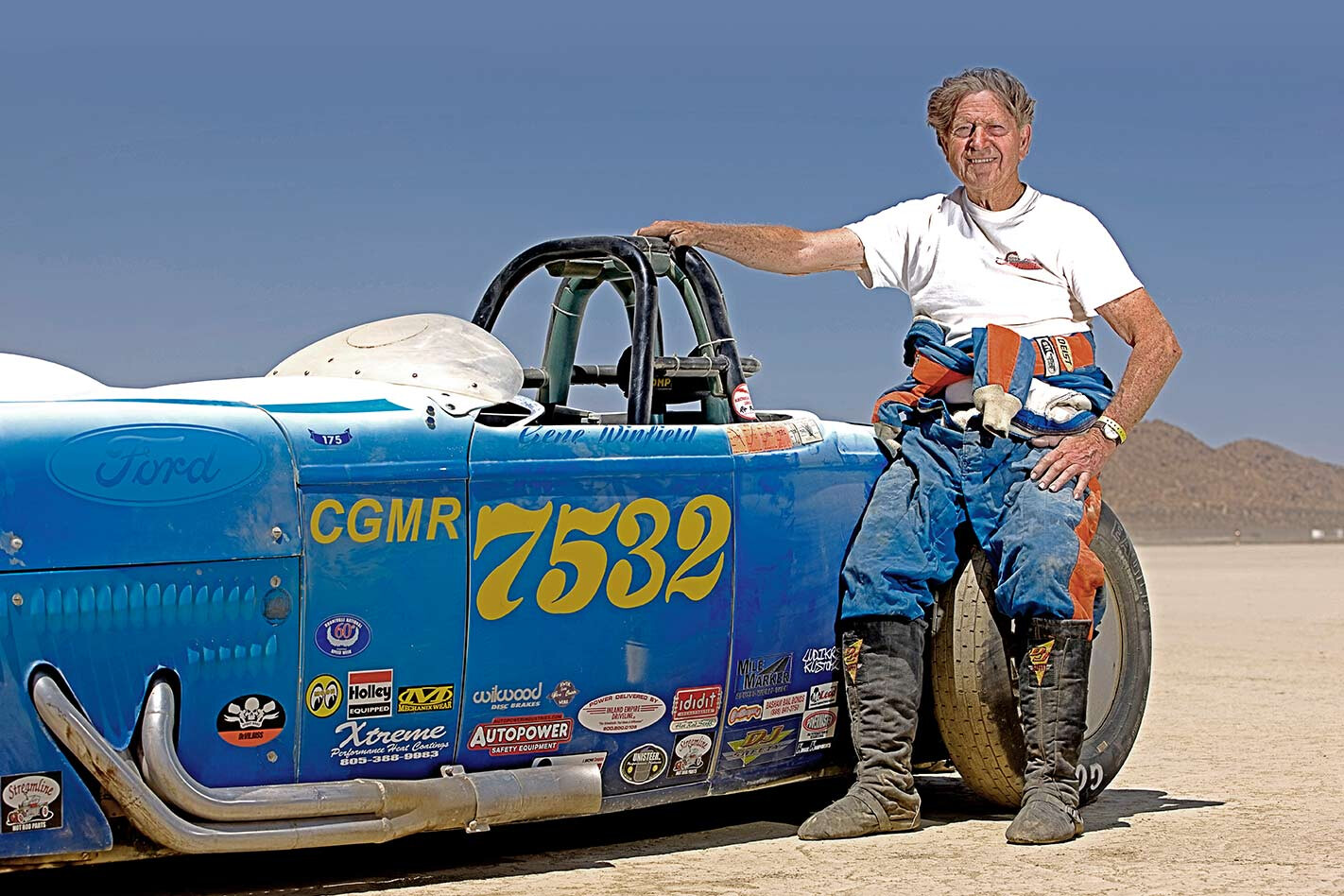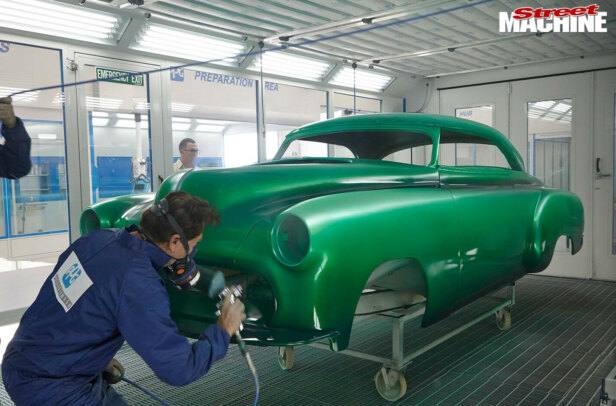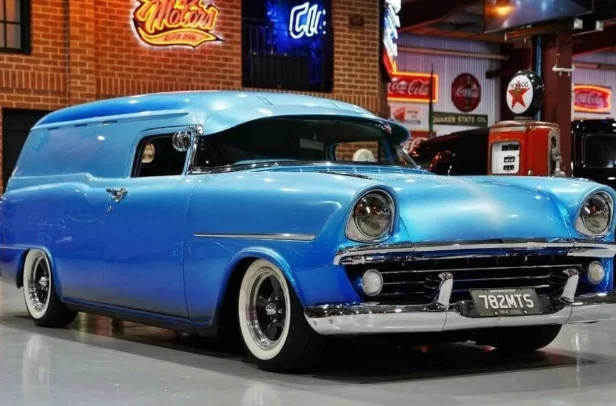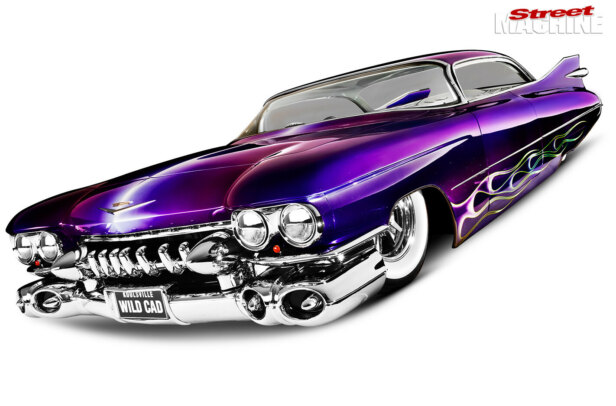This article was first published in the August 2009 issue of Street Machine
WHEN the wind blows, it blows hard at El Mirage. It whines across the dry lake bed in California’s Mojave desert, sending sand spiralling into the sky. Gene Winfield has seen it all before. He’s been coming here since before many of today’s racers were born and a few dust devils aren’t going to spoil his fun.
Gene’s just completed his first run of the morning and, all things considered, he’s looking calm. Maybe he should have pedalled his ’32 roadster like some of the other early-bird racers did but that just ain’t Gene’s style. Never was, never will be.
Gene back in the early 80s, beside a sweetly chopped ’46 Ford coupe
It looked a little rough out there. What happened?
Well it was very slippery and the wind was blowing me sideways from the right. I got off the course and was hitting the cones so I got off the throttle, got back on the course and hit the throttle again. So I only ran 179mph but I was happy with that, considering I had to take my foot off the gas.
Usually if you get a little bit sideways in a roadster it will spin but I have 26 degrees of caster in the front end and almost 600lb of lead in the front too, so it goes very straight. At Bonneville last year I got a little bit sideways and I had to let off, then corrected, got back on it and went 203mph.
Gene’s lakester is based on a Brookville steel body; he built the chassis, aluminium nose, boot lid and tonneau. Engine is a Robert Yates 368ci Ford NASCAR engine, with a single 1000cfm Holley, backed by a Tremec five-speed
It’s a long time since you first raced here. What does El Mirage mean to you today?
The course is the same as it was back in the day but it was a little smoother then. And of course you didn’t have as many cars running. In the 50s and 60s you’d maybe get 75 cars; today it’s more like 200 and that chews up the track. Now there’s more high-tech equipment. Back in the day it was all flatheads and GMC six cylinders.
What inspired you to start racing again?
Out at Bonneville they call it Salt Fever, and it gets in your blood. It’s true that I was away from land speed racing for a number of years in the 1970s but I always wanted to run again.
The Pacifica — a wild custom ’63 Econoline built by Gene for model company AMT and Ford. Gene has a replica in the works!
Away from the racing, what was it like when one of your cars was on the cover of a magazine?
It was great. I started off street racing in a roadster I’d built, then little by little I got into the custom end of it. People would bring over a car and want the hood or trunk rolled off, or the emblems removed and the holes welded up. I was also building flathead engines and had a little speed shop. I was doing all this at the back of my mother’s house, in a chicken coop. I put in a cement floor, added a spray booth. I was moving towards customs and away from the street racing. Then I decided to go up town to a bigger shop. I started off as Windy’s Custom Shop, then changed to Winfield’s Custom Shop, and later it became Winfield’s Special Projects because I was building more movie and television cars at the time. I have all those different business cards and I’m going to put them in a museum I am building now.
The ’56 Corvette Gene built for customer Mike Sparrow, which featured Aztec Gold paint, white Naugahyde trim, shaved decklid, extended rear guards and a hardtop vent
A Winfield museum?
Yeah, it’s going to be a memorabilia museum rather than a car museum. It’s based around a house where the kitchen will be 50s and 60s. One of the bedrooms will be 40s and 50s. Then for another bedroom you will have to push a Star Trek emblem and the doors will slide open sideways, just like I did on the Galileo 7 Shuttle Craft.
What was it really like working for Hollywood, on the TV and movie cars?
It was great. Some of the directors were hard to work with because they wanted everything perfect and then you wouldn’t see the details in the finished cut, but it really was wonderful. But when I moved out of LA and into the desert, I decided not to do any more film work. Some of the movie companies screwed me around. I bid on a big movie and made 21 trips to Hollywood with different artwork and then someone else got the job so I said: “To heck with it.”
So what is life like these days, living out in the desert?
I bought five acres out in the desert because I couldn’t find anything big enough that I liked in Los Angeles. I like it very much and I’m going to continue to build cars. People ask me all the time when am I going to retire and I tell them: “When they put me in the ground.” I’m very fortunate to have inherited good genes from my mother, who lived to be 94. I don’t drink, I don’t smoke, I eat good food, I take vitamins and I exercise almost every day.
So what cars are you working on right now?
I’m chopping a bunch of tops. I just chopped a ’50 Buick Fastback. When you chop one of those, you have to cut a wedge all the way through to the bottom of the trunk. I also did a ’49 Chevy fastback and I’ve started a project for myself. Back in 1963 I built an Econoline pick-up for Ford, called the Pacifica. Well I just started building one for myself. Two weeks ago I sectioned the front half just like I did back in the 60s and I’m going to put in asymmetrical headlights and tail-lights. Everything will be identical to the original, including the paint. And I’m building a replica of the ‘Solar Scene’ for a customer, including the Buick nailhead engine.
Gene did a lot of work on LeRoy Goulart’s already wild ’51 Ford, including quad canted headlights, sculpted fenders, and paint
How did it feel when manufacturers put rod and custom builders out of business with their muscle cars, then came to you, begging for design help?
It was nice of them to come to me for help with their projects but it was very disappointing because they flat aced me out of business. In the late 60s, custom cars went down to the basement — it was all done. It wasn’t until the early 80s that it started to come back. I was surprised it was happening again but I immediately jumped on it and started building parts for Mercurys and I’ve been in it ever since.
So who comes to you for a car these days?
I get young people who’ve been looking at the magazines all their lives and some older people who’ve had a hot rod for years. Now their families are too big to fit in a rod so they need a larger car, and they also have the money to build the custom they always wanted.
The Jade Idol is Gene’s most famous creation, a ’56 Mercury two-door hardtop built for $15,000, for owner Leroy Kemmerer
Looking at the cars you’ve built, they’re still brilliant today. It’s quite a trick to make something with lasting appeal.
I think the reason for that is I’ve always liked clean styling. Jade Idol was a radical custom but it was smooth. I always enjoyed building rods and customs more than movie cars because they were well finished; the movie cars had to be built to a budget and were fairly rough. I like to create things that are a little different. I’ll look at something like a grille and think about how many ways I can change it. I might come up with seven or eight ways. Then narrow it down to three and finally one. Then I build it. I try to be clean, simple and elegant.
What do you think about the modern builders and scene?
I like a lot of the stuff they’re doing. There is some good engineering and ingenuity in the cars. Then some of them are the other way — they’re pieces of trash and I don’t like that. A lot of people are trying to do what we did back in the day. In the early days we couldn’t afford paint so we didn’t paint them for years, but later we might. Some of these guys today never expect to paint them and build them as trashy as possible.
Dennis Reinero’s 1956 Olds 88, a rare four-door custom out of Gene’s shop, that featured on the cover of Custom Rodder
There’s more interest in you and your cars than ever. How does that feel?
That’s true. It’s very gratifying and I enjoy it, naturally. So I’m finally getting some of the recognition that I mighta shoulda had earlier in my career.




Comments